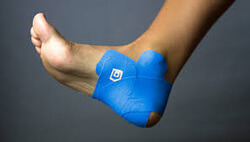How to heal Ankle Sprain, by Pedro Olabarri

Ankle Sprains
Factors that can increase the risk of this type of injury:
.Poor ankle flexibility.
.Weakness of soft tissue structures (muscles/tendons/ligaments) that cross the ankle joint.
.Running on uneven surfaces.
.Inadequate trainers or trainers “past sell by date”.
.Previous injuries, especially those which were not rehabilitated properly.
.Overtraining and lack of rest.
.Gait imbalance.
.Improper warm up and lack of stretching.
.Inadequate joint proprioception and slow neuron muscular response to an off-balance position.
.Poor hydration and inadequate training.
Assessing running technique, ensuring rest days are incorporated into routine and following a well-balanced diet can minimise the risk of re-injury. Warming up, stretching as well as using adequate running shoes may also help to prevent any further injuries.
The rehabilitation plan to get an injured ankle back to its full functionality should include the following steps:
Stage 1: Acute phase (Days 1 to 3)
.Treatment at this stage consists of protection, rest, icing, compression and elevation (PRICE).
This helps to control and support the effects of inflammation.
.The massage intervention would include passive movement mid-range, general massage and lymphatic drainage with caution, proximal to the injured area.
.Support rest with full-body massage.
.Strapping if necessary.
.If the ankle does not improve after 3 days, medical assistance should be required.
Stage 2: Sub-acute stage – Repair and healing (Days 3 to 21)
.Hot and cold therapy.
.Controlled motion – Range Of Motion active and passive in mid-range – It helps to identify any compensation patterns.
.Cautious and controlled soft tissue mobilisation of scar tissue along fiber direction towards injury – It promotes development of scar tissue.
.Soft and light friction (not too early in sub-acute stage) can help to break down adhesions.
.Light stretching, especially at the end of the sub-acute stage, may result effective in creating movement and increasing flexibility of the injured tissue.
.Support healing with full-body massage
Stage 3: Remodelling
.Active and resisted Range Of Motion (full range) along with progressive stretching.
.Friction on injured site to break down adhesions and support alignment of scar tissue.
.Full body massage to support rehabilitation activities.
It is important in all 3 phases to address muscle imbalances and compensation patterns. It is also vital in the rehabilitation process to decrease pain, reduce inflammation, increase ROM and regain strength and flexibility to prevent further injury.
Appropriate exercises immediately after sprain will improve function and recovery. Strengthening and stretching exercises, for instance, will help to improve ankle mobility.
During the rehabilitation process it is convenient to perform alternative activities (ensuring the injured tissue does not get involved) so the client can maintain their fitness levels. For example if a lower extremity injury occurs pool activities can be suitable. This will allow the client to start mobilising the injured tissue progressively.”
